So we are once again about to go off into the back of beyond with no internet access, so don't be surprised that there are no blogs for a couple of weeks. However it should be worth a visit when we're back online, as the place we are heading to tomorrow is Antarctica.
Are we excited? Absolutely!
See you in March when my fingers have thawed out.
Welcome to our travel blog. We are Tabitha and Nic. In 2011 we 'retired' in our early 40s and set off to travel the world. We spent our first year in South America and have been lucky enough to make two trips to Antarctica.
Our blog is a record of our travels, thoughts and experiences. It is not a guide book, but we do include some tips and information, so we hope that you may find it useful if you are planning to visit somewhere we have been. Or you may just find it interesting as a bit of armchair travel.
Sunday, February 26, 2012
More of Sea Lion Island
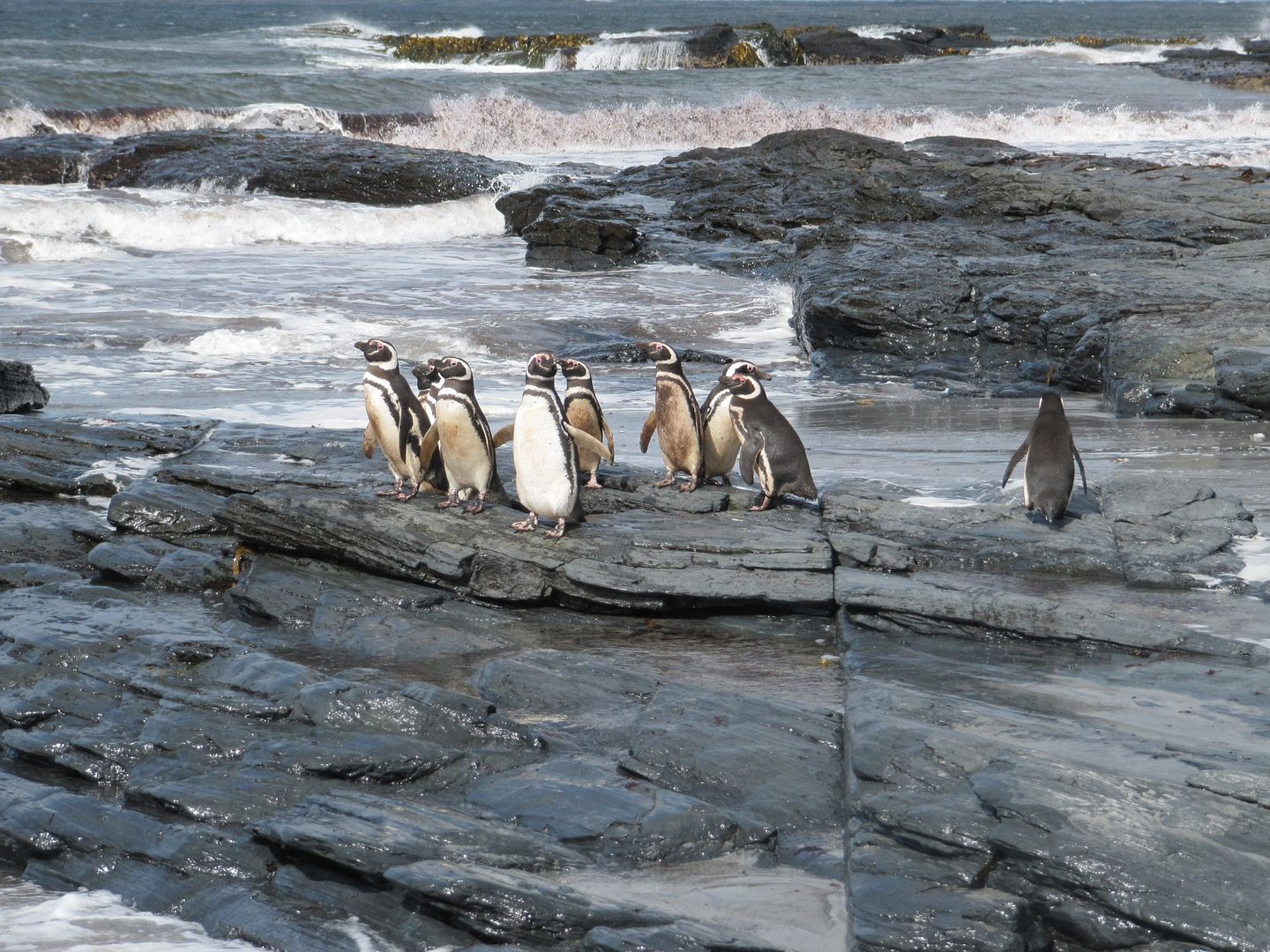 |
| Magellanic penguins |
We walked over to the beach where the elephant seals and magellanic penguins would be, and where you can sometimes see orcas out looking for a meal. There were no orcas out today though.
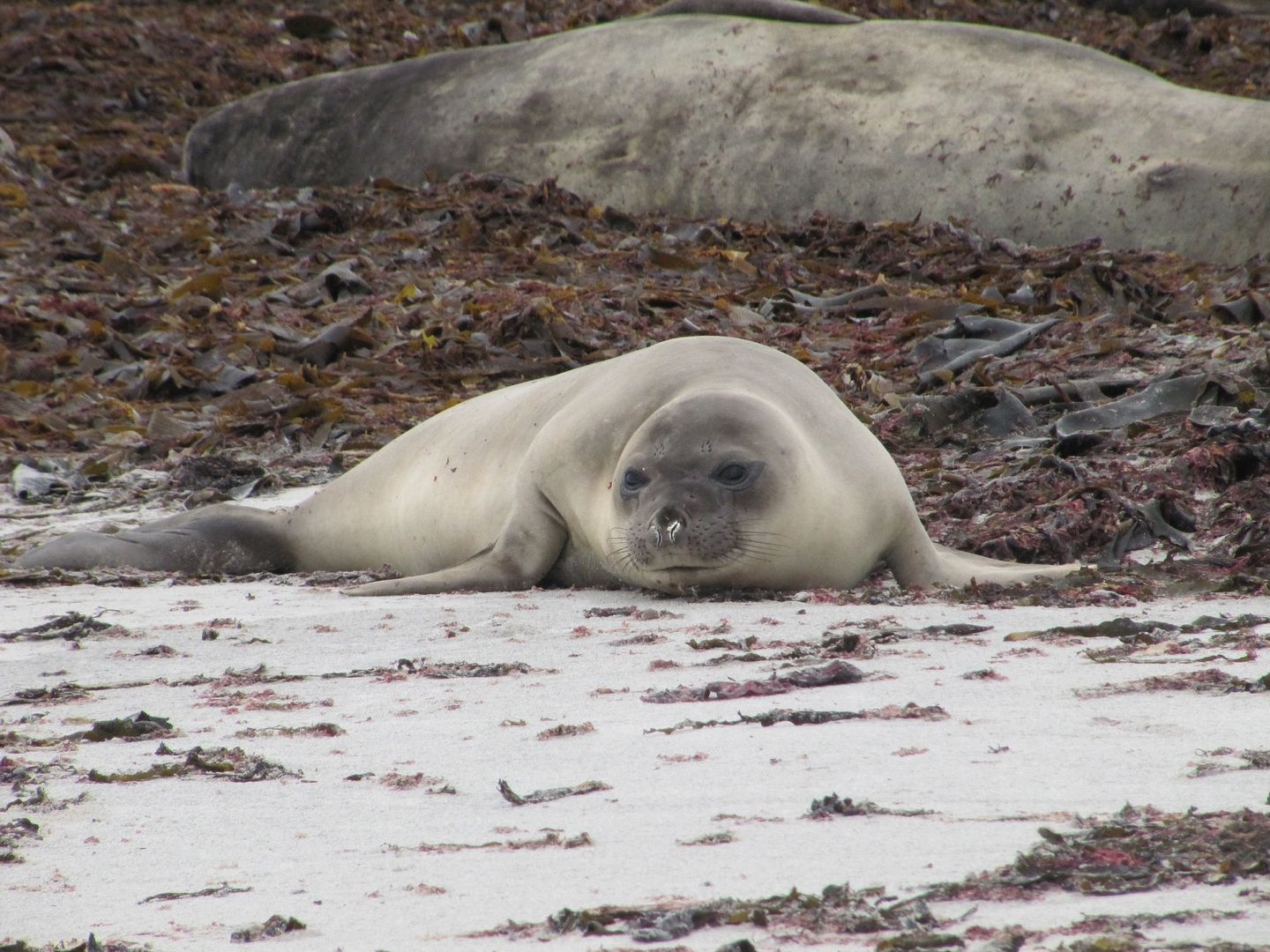 |
| Elephant seal |
The magellanics kept their distance - they do seem to be the most timid and least friendly of the penguins we've encountered so far - but it was still good to watch them hovering around the water's edge, apparently not being entirely sure whether or not they wanted to take the plunge into the cold sea.
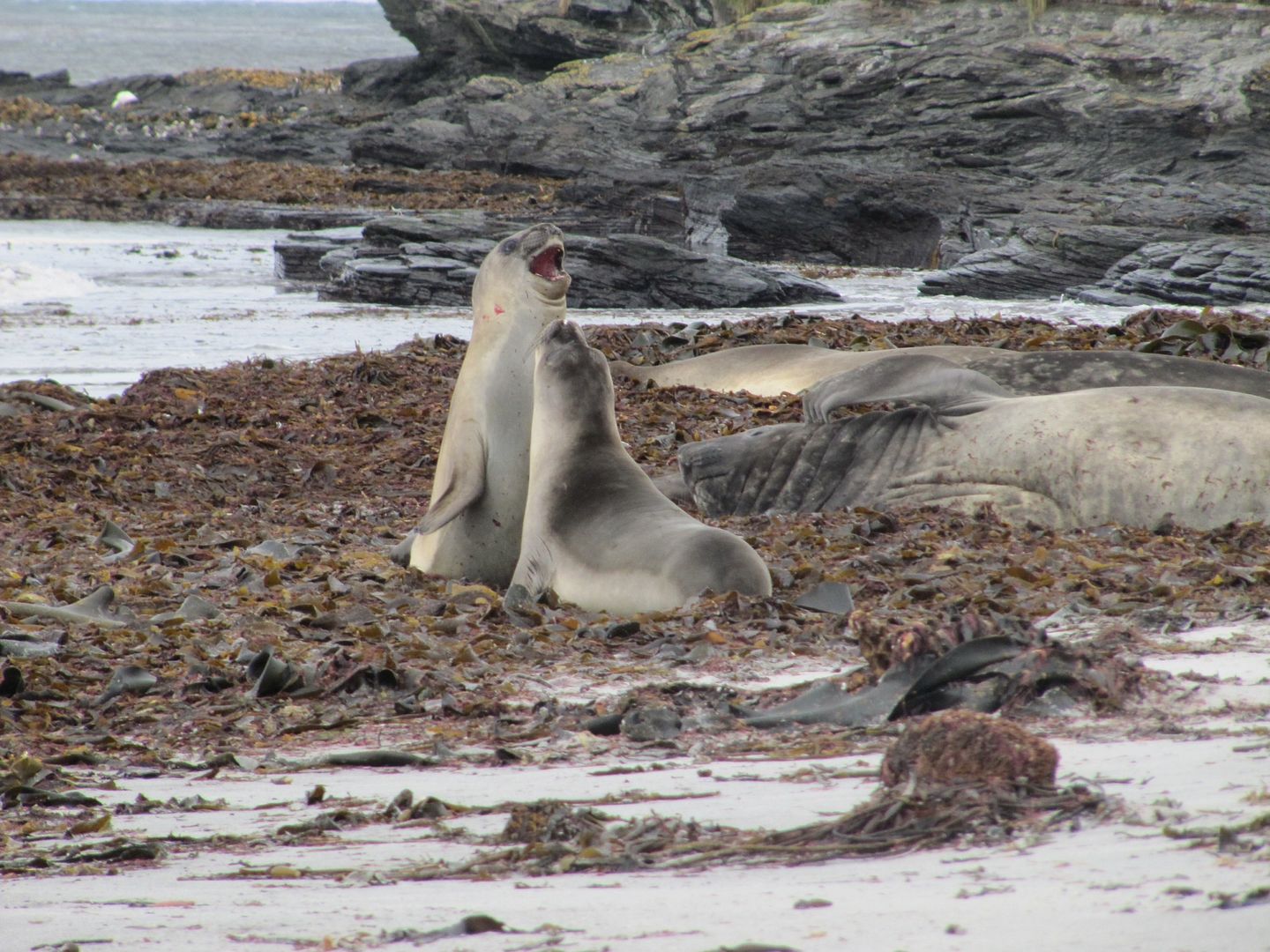 |
| Elephant seals squaring up |
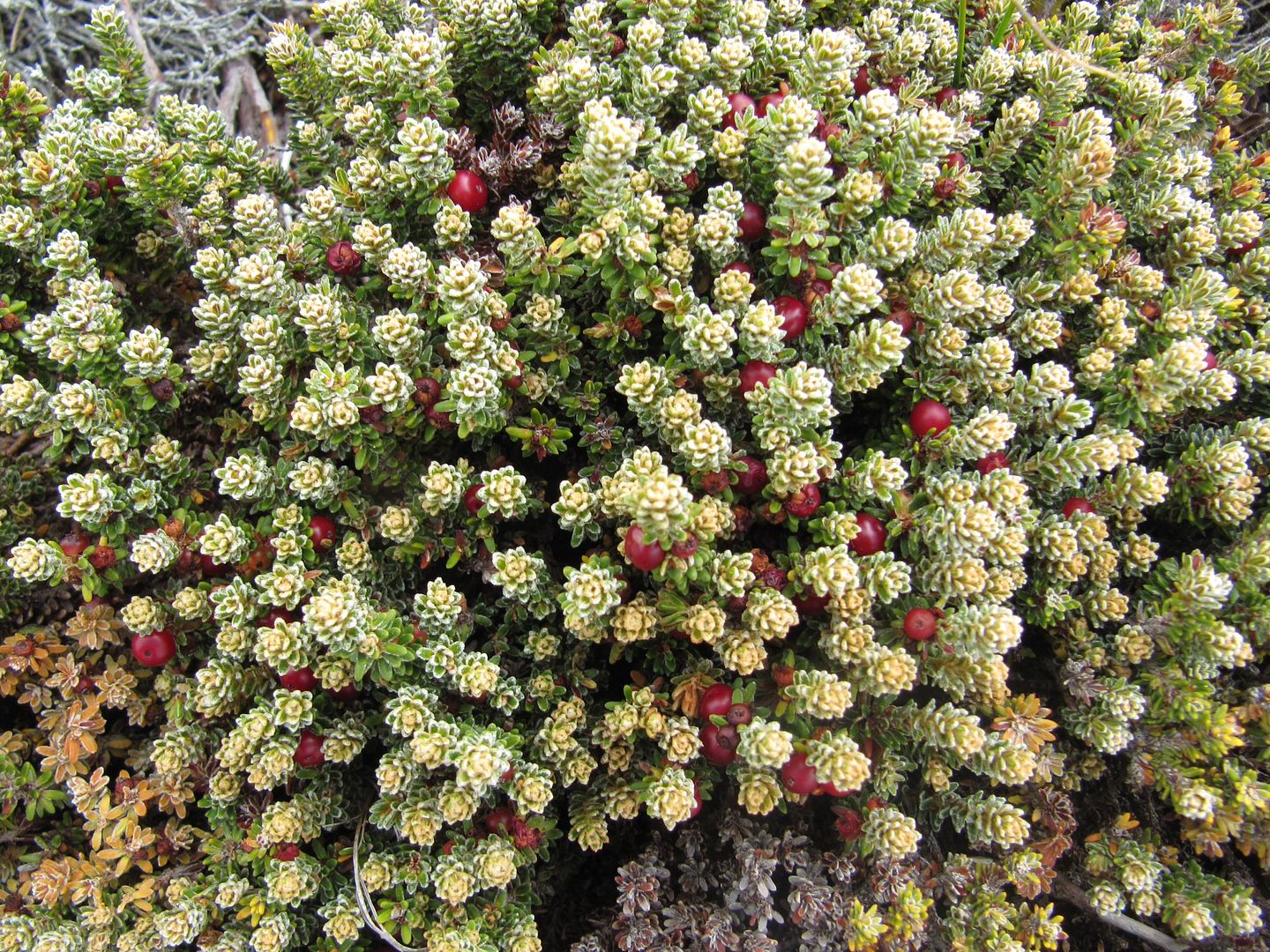 |
| Diddle dee |
 |
| Snipe |
Although the other birds along the way weren't our main interest, we were at least able to recognise a few of the main types found here. There are the little snipes that run around in amongst the grasses and the diddle dee, the bigger striated and crested caracaras, and the even bigger turkey vultures. We had no idea what most of the others were, but never mind.
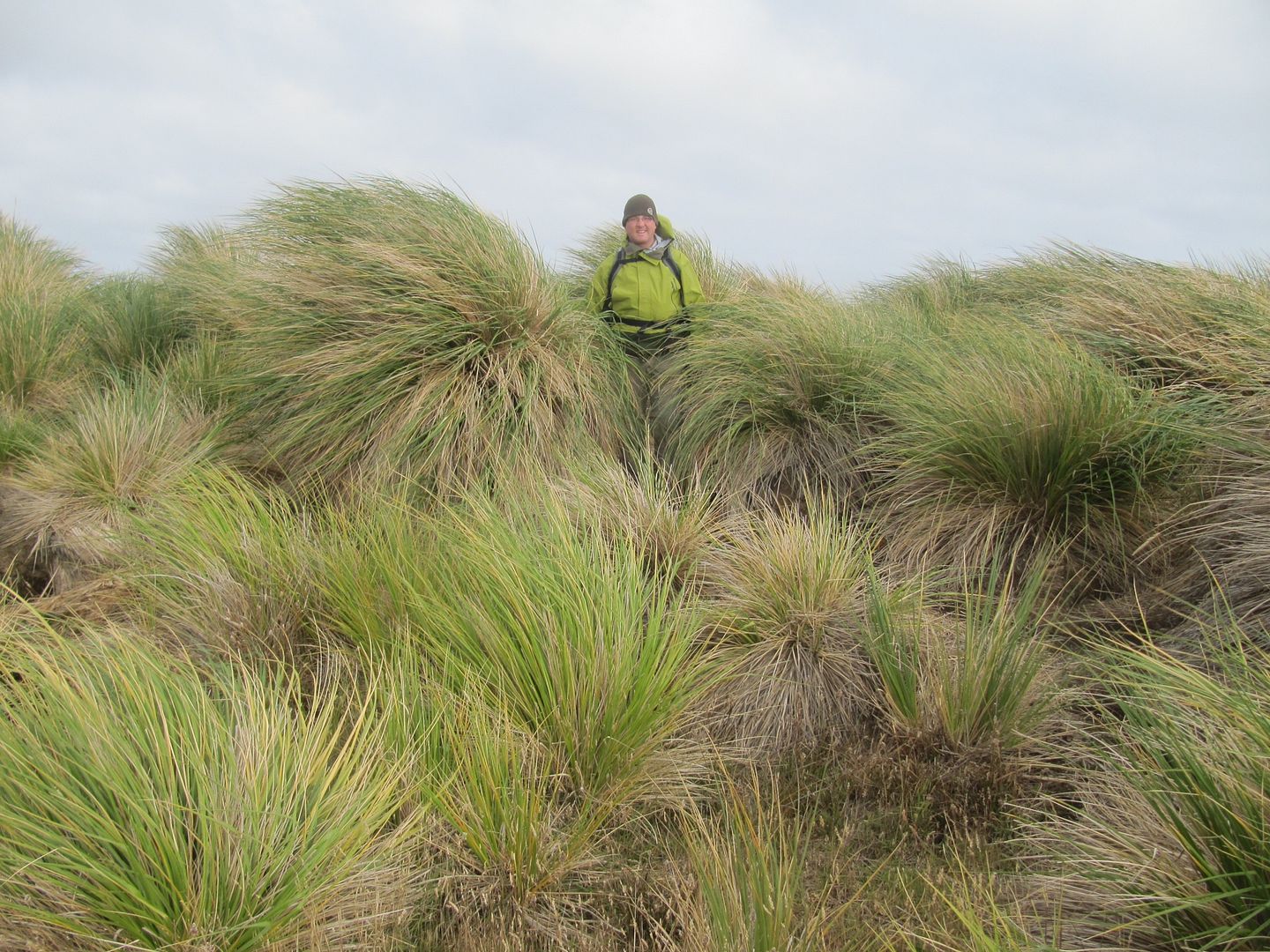 |
| Nic in the tussac grass |
This time we did make it the two and a half miles to the rockhoppers. We took the longer route around as we had been warned that it is possible to get horribly lost in the huge tussac grass. Seeing the size and expensive of it for ourselves, we could see the potential for trouble so kept well away.
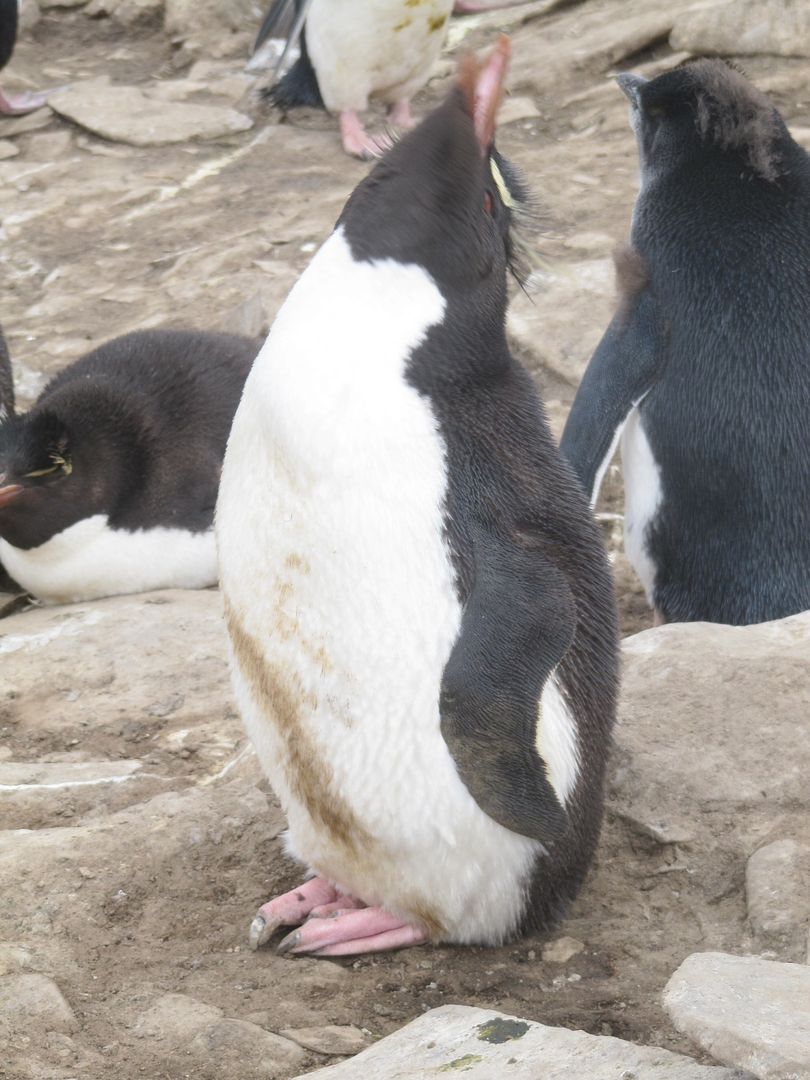 |
| Rockhopper calling |
The rockhoppers are probably the cutest looking of the penguins here and it is fascinating the way they hop along and over the rocky area they choose to make their home on. Most of the ones here are the chicks, not yet ready to go out to sea themselves. There are some adults standing guard, but most are out getting dinner for the little ones.
 |
| Rockhopper penguin |
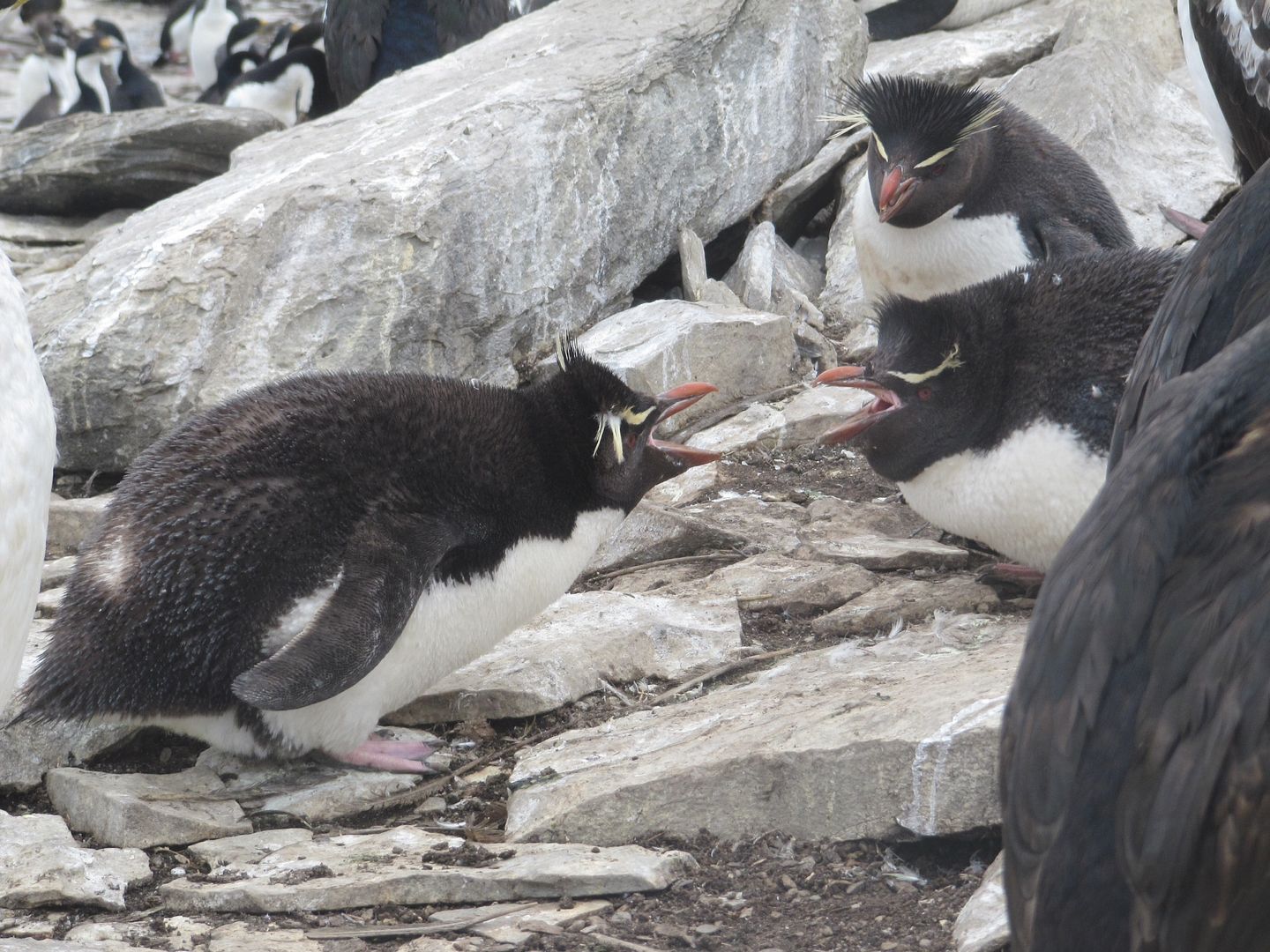 |
| Rockhopper penguin spat |
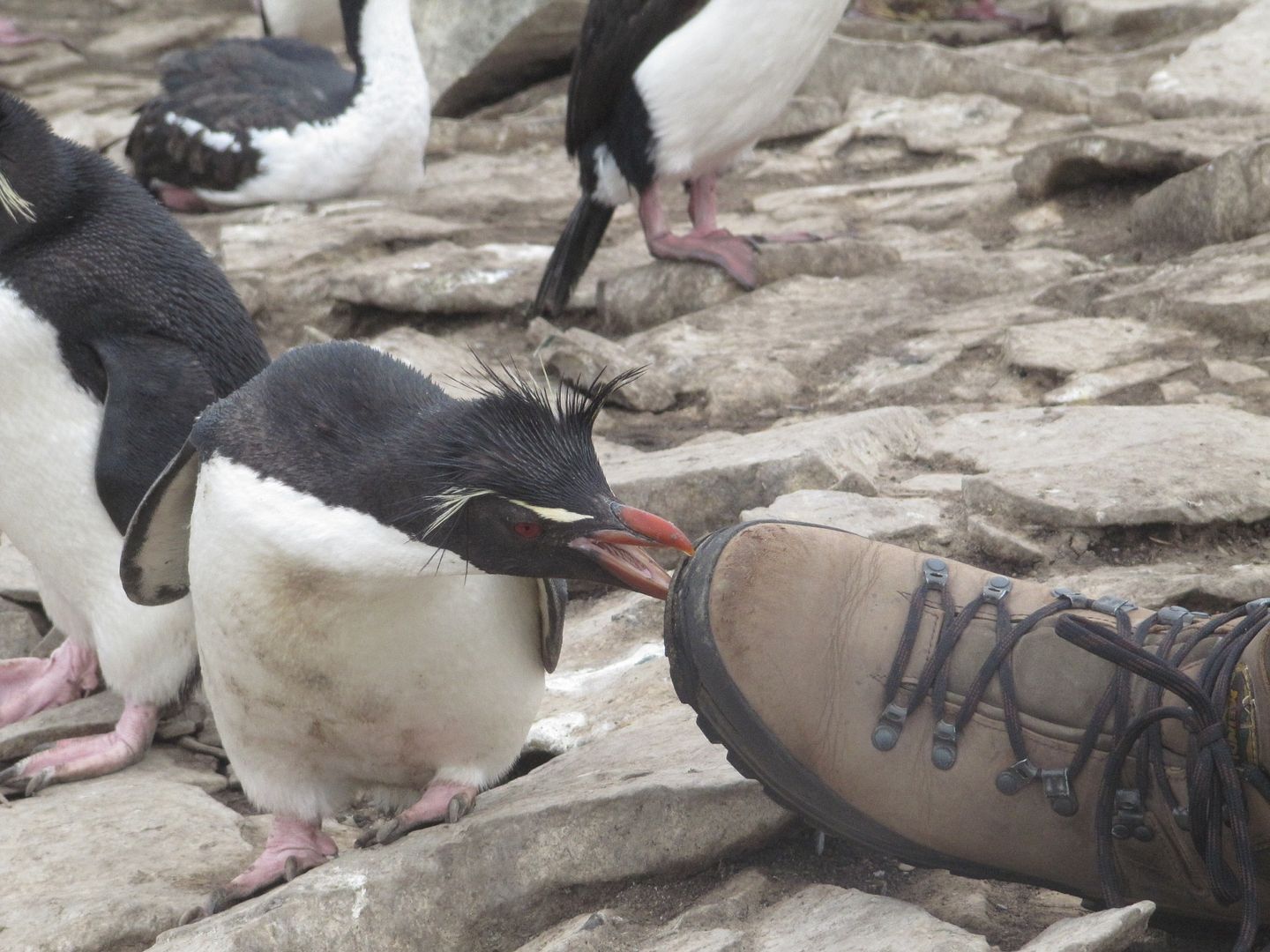 |
| Rockhopper pecks Nic's boot |
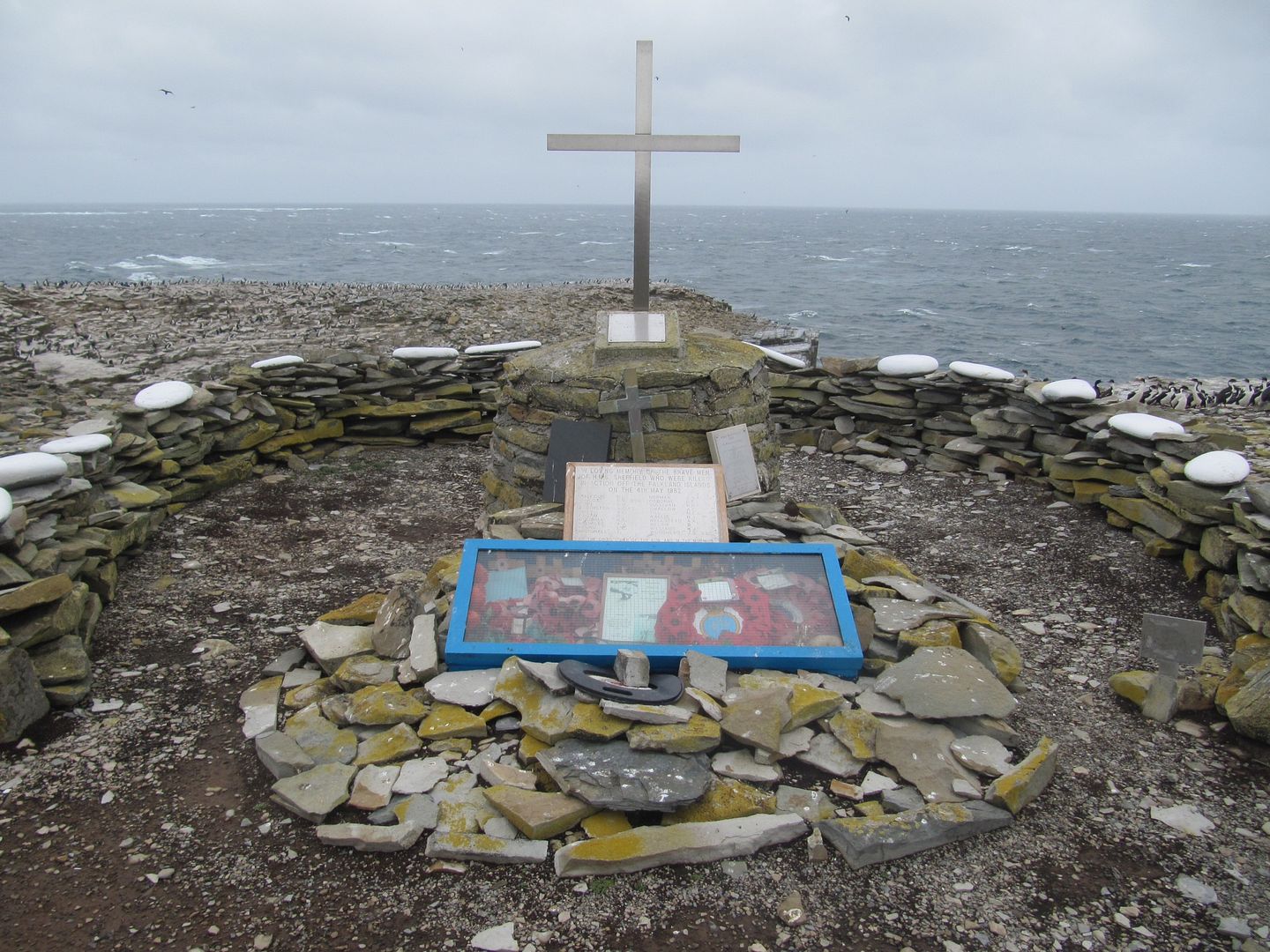 |
| HMS Sheffield Memorial |
We stayed watching them for about an hour or so before heading back to the lodge to warm up and have dinner.
First though, we took a look at the nearby memorial to HMS Sheffield and those who died on it in 1982. The islanders are grateful to those who freed them and, along with those who visit to pay their respects, they take good care of the various memorials on the islands.
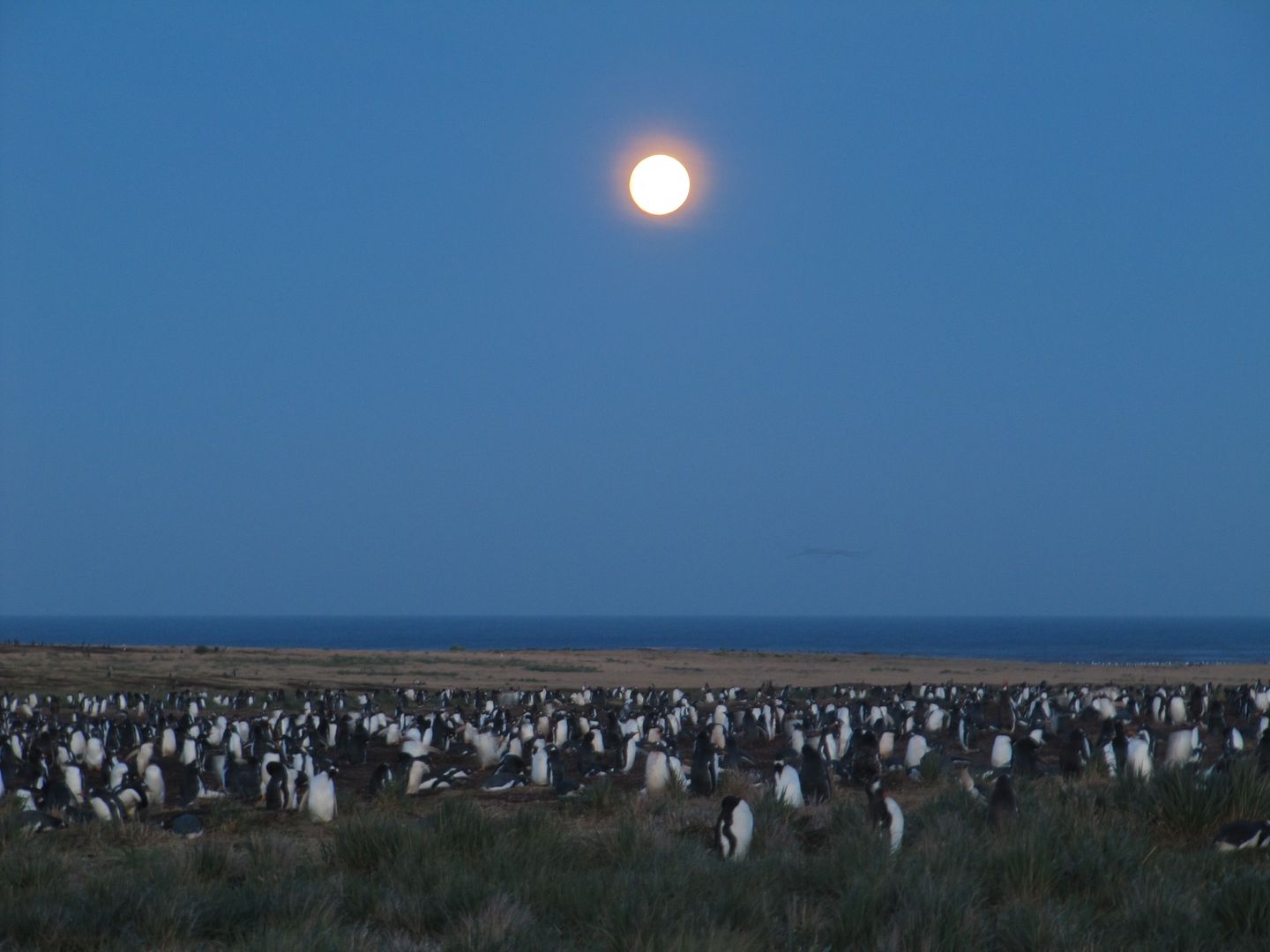 |
| Gentoos in the moonlight |
In the evening there was a fabulous moon above the Gentoos, which looked really amazing. Again sadly my pictures don't do it justice.
A tour of Sea Lion Island
In the lodge we had tea and coffee waiting, but we were somewhat more interested in looking out of the lounge windows to see the hundreds of Gentoo penguins about a hundred and fifty metres away.
In the afternoon, Jenny drove us around the island to show us where the various wildlife could be found. Our first stop was at the top of the cliffs where we could look down onto the sea lions. At first you think you can just see the rocks, and then one of the rocks moves and you realise it is a sea lion after all. Once your get the eyes accustomed, you can spot them all. And you can easily hear the males' loud roars. You just have to be a bit careful not to get too close to the edge as the winds are pretty gusty and it's a long way down.
Next were the elephant seals and a few Magellanic penguins. We took a bumpy drive through the huge tussac grass, and came out onto the beach to find the penguins running along in front of us. They mostly kept their distance, but not far from where we stood was a small group of elephant seals and a big male sea lion.
Elephant seals (and sea lions) can move a lot faster on land than you would expect, and they can be quite nasty if they feel threatened, so the rules are to keep at least three of their lengths away from them, and don't get between them and the sea or their cubs if they have them. We kept the appropriate distance and didn't seem to bother them, though we could see that there was normally at least one of them keeping a watchful eye on us just to be sure we didn't need to be seen off.
Our third stop was heralded by that horrible fishy smell that you get around big groups of seabirds. It was a large colony of king cormorants with some imperial cormorants in amongst them.
With the number of birds flying around, we regarded ourselves very lucky not to have been pooed on by the time we left.
Then it was off to see the rockhopper penguins. They were nesting alongside more cormorants and it was strange to see the two very different birds sharing the space. It seemed to confuse one of the baby rockhoppers, it was standing looking up at the cormorants flying above it, and was flapping its wings as hard as it could as if it thought it should be able to fly too.
We spent some time watching a couple of chicks chasing around one of the adults for a feed. The adult was happy to feed one, but not so keen on the other. We weren't clear if the second was supposed to get food from it or not, but eventually another adult seemed to intervene on the second chick's behalf and persuade it to feed that one too.
Back towards the lodge, we stopped off at the beach to watch the adult gentoo penguins coming back from the sea. From being little black and white specks, bobbing around out at sea, you could gradually see them a they got closer, porpoising in and out of the waves.
Some of them timed it right so that they came in gently and were able to waddle out of the water, but others came crashing in on their stomachs and slid up on to the sand. Most of them then hung around the beach for a while, perhaps swapping stories of what they had caught and the ones that got away, before tottering their way up to the grass by the lodge.
We didn't want to disturb them as they walked back, so we took a wider route around, only to suddenly realise that we were in the middle of the magellanic penguins burrow territory. The magellanics make little burrows in the ground rather than nests, and we were now picking our way through a multitude of them, trying not to step on the shallow entrances that could easily collapse.
Most of the burrows are empty by this time of year, so walking through was not going to disturb them, and we took care not to get too close to those where a penguin was still standing sentry over its chick. These ones were quite amusing as they watched us get nearer, twisting their heads around so that they could see us better. They seemed to realise that we weren't a threat, and were going to pass by, but still they would dip into the burrow just to be on the safe side.
We made it through without stepping on a penguin, or getting attacked by the skuas that also had nests around and are quite vicious if you get too close to them, and got back to the lodge for tea and cake.
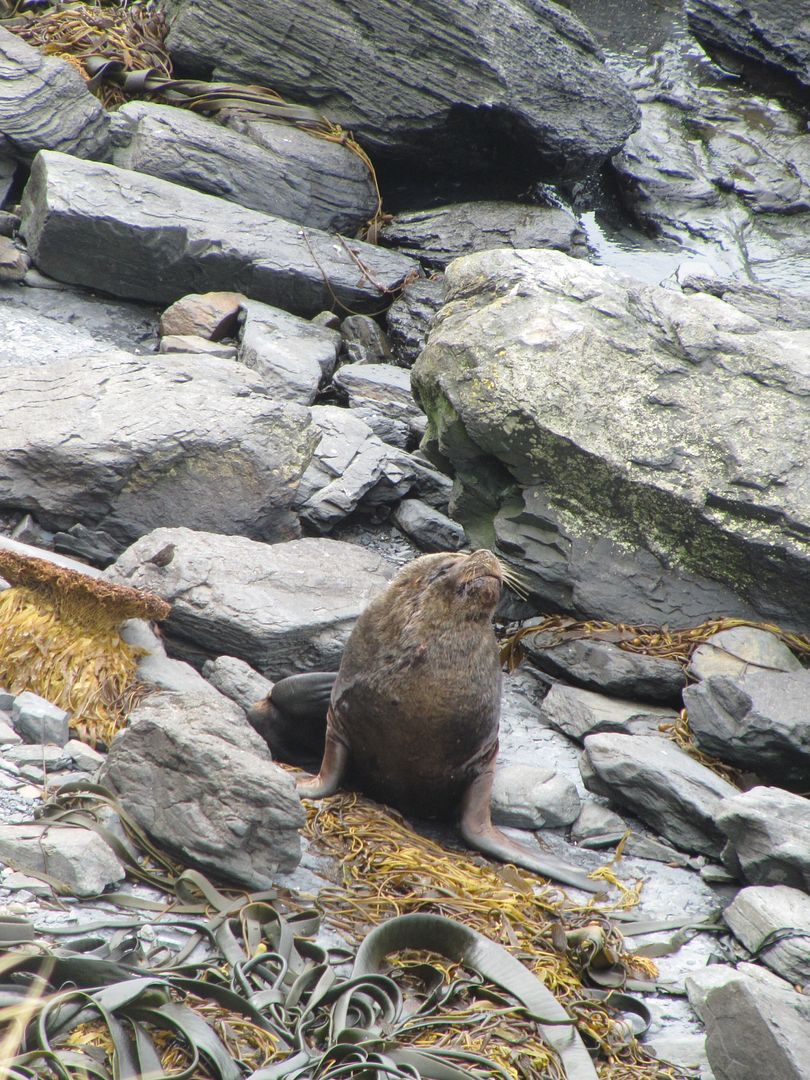 |
| Sea Lion on Sea Lion Island |
In the afternoon, Jenny drove us around the island to show us where the various wildlife could be found. Our first stop was at the top of the cliffs where we could look down onto the sea lions. At first you think you can just see the rocks, and then one of the rocks moves and you realise it is a sea lion after all. Once your get the eyes accustomed, you can spot them all. And you can easily hear the males' loud roars. You just have to be a bit careful not to get too close to the edge as the winds are pretty gusty and it's a long way down.
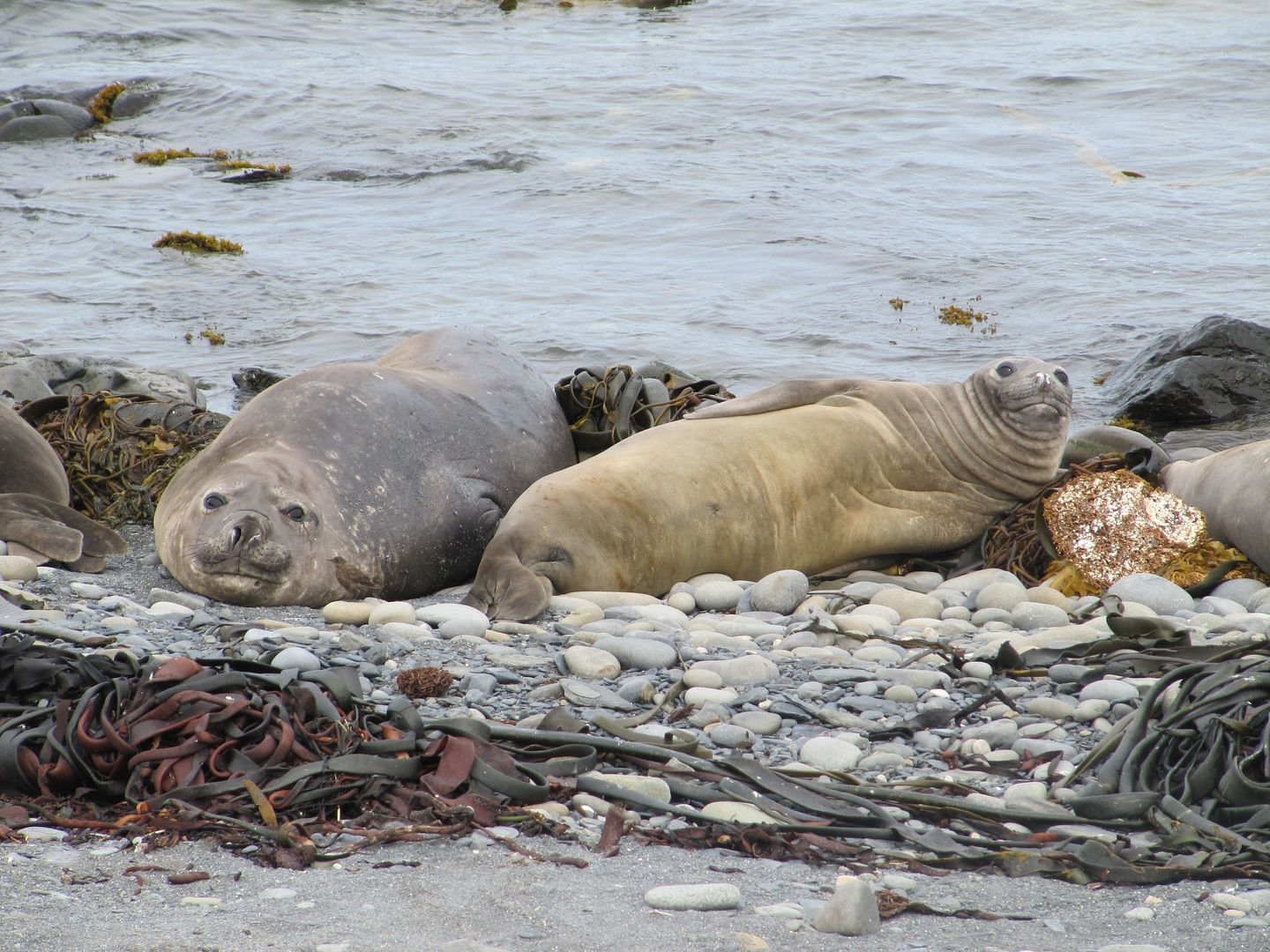 |
| Elephant Seals |
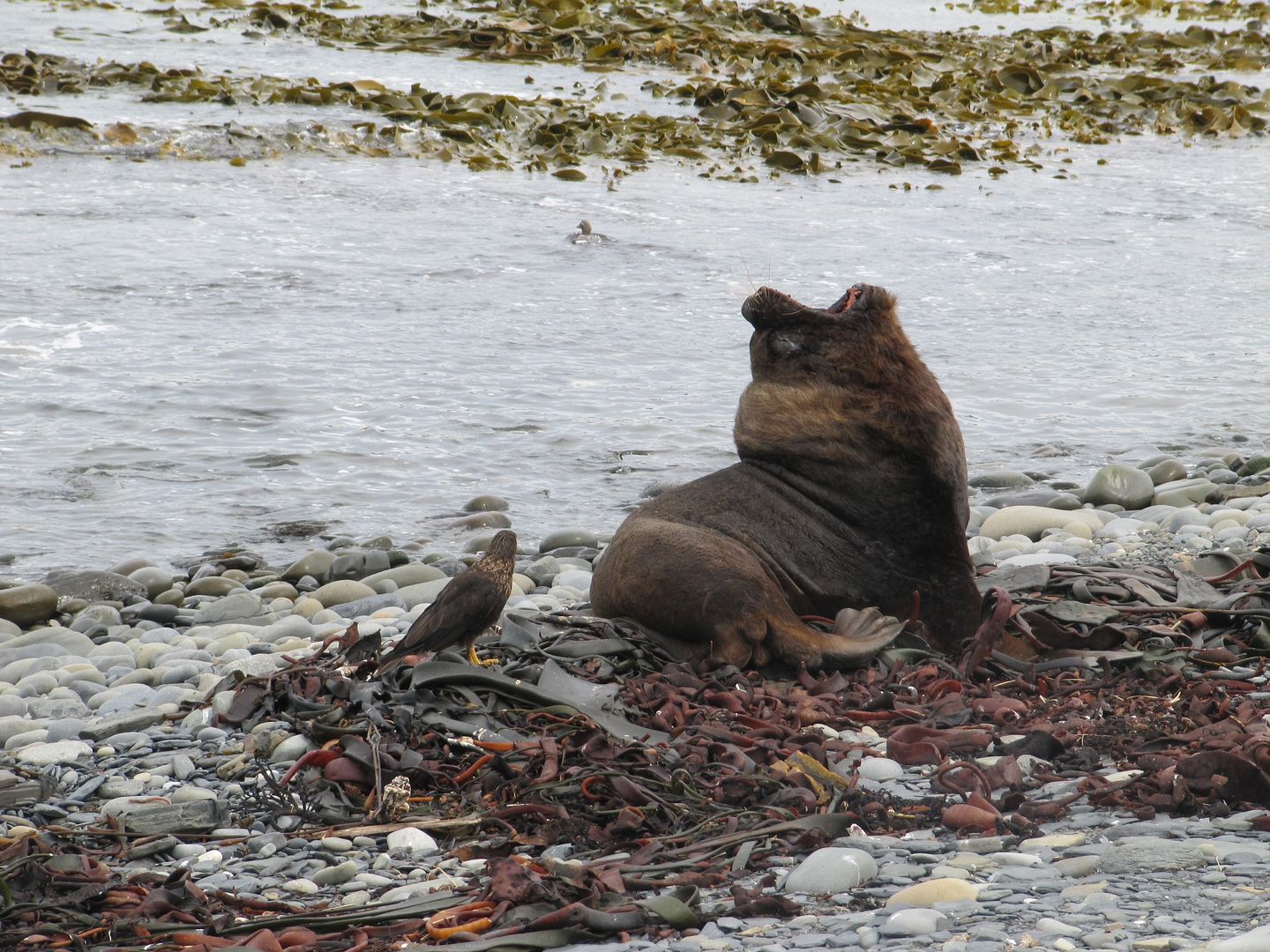 |
| Sea Lion roaring |
 |
| King and Imperial Cormorants |
With the number of birds flying around, we regarded ourselves very lucky not to have been pooed on by the time we left.
 |
| Rockhopper penguin |
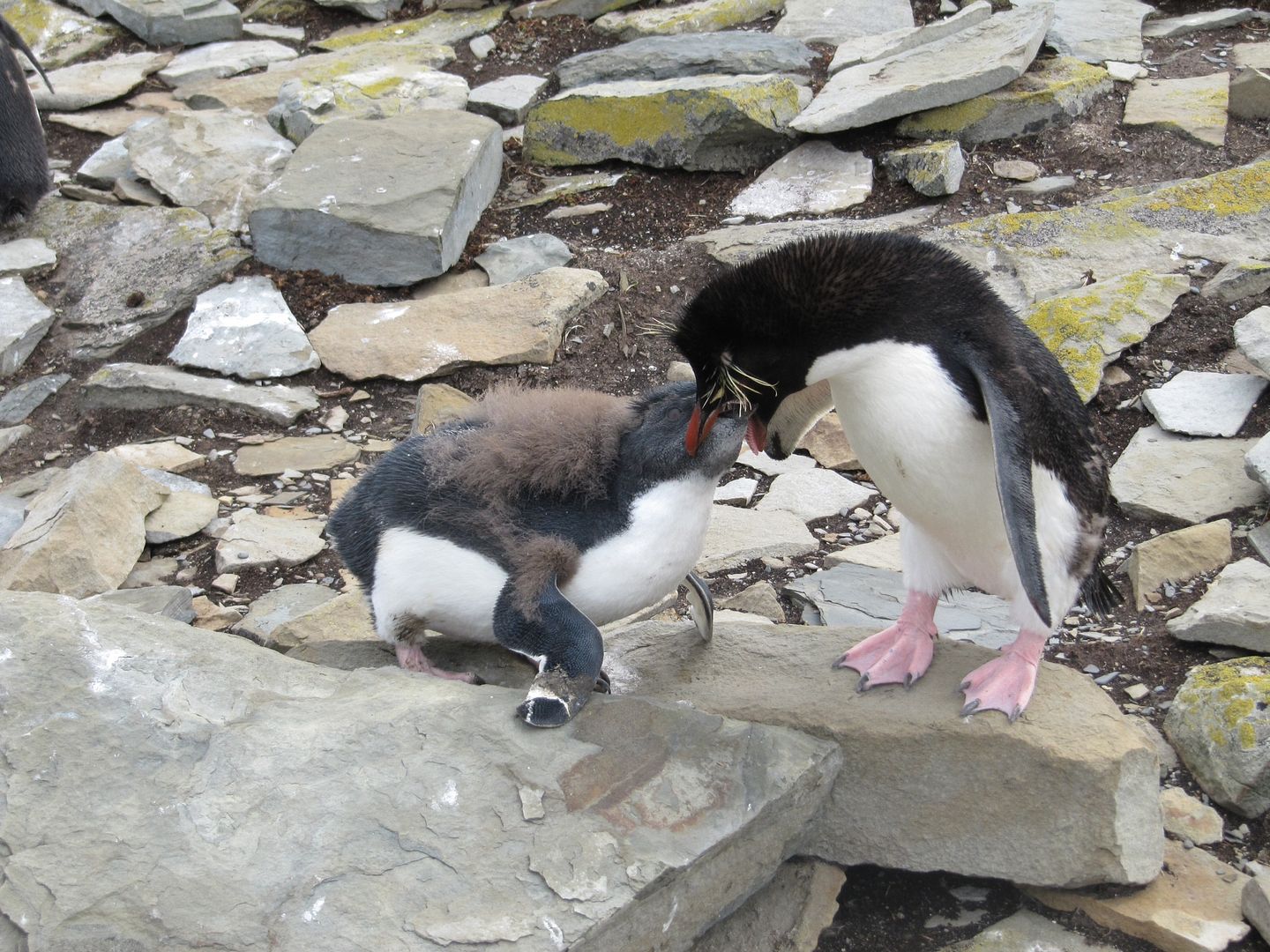 |
| Rockhopper chick feeding |
 |
| Porpoising Gentoo Penguins |
Back towards the lodge, we stopped off at the beach to watch the adult gentoo penguins coming back from the sea. From being little black and white specks, bobbing around out at sea, you could gradually see them a they got closer, porpoising in and out of the waves.
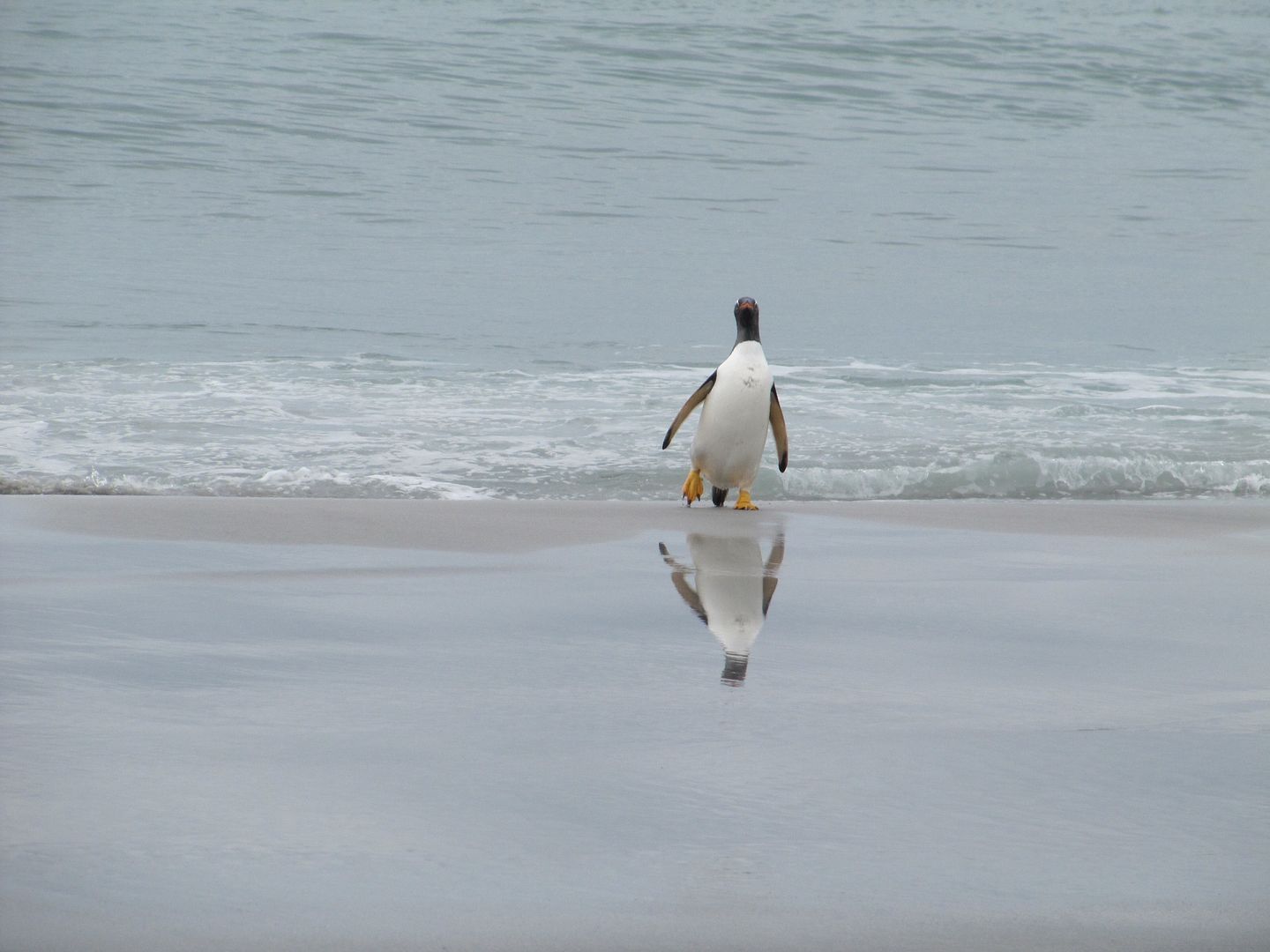 |
| Gentoo penguin |
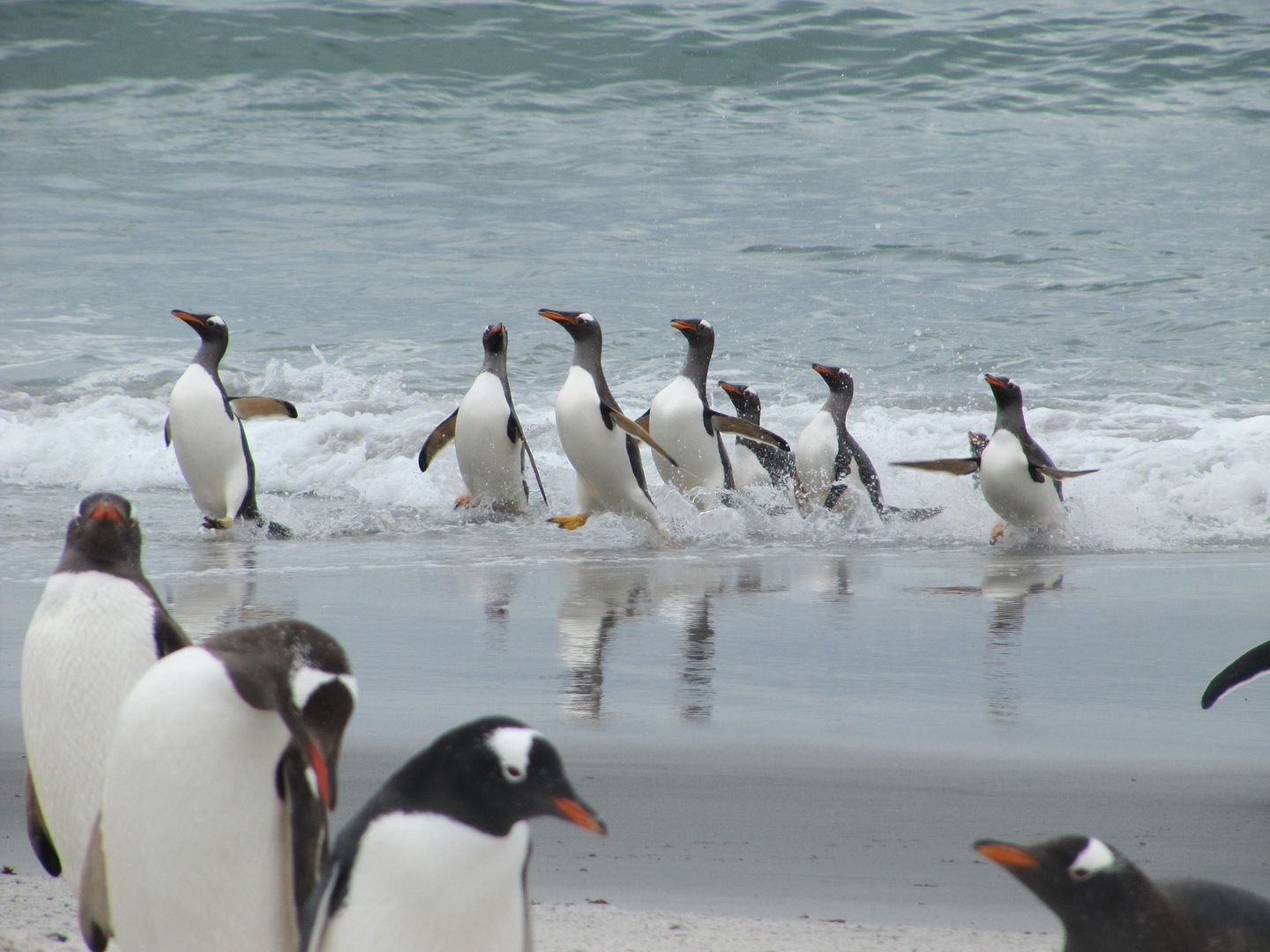 |
| Gentoo penguins coming to shore |
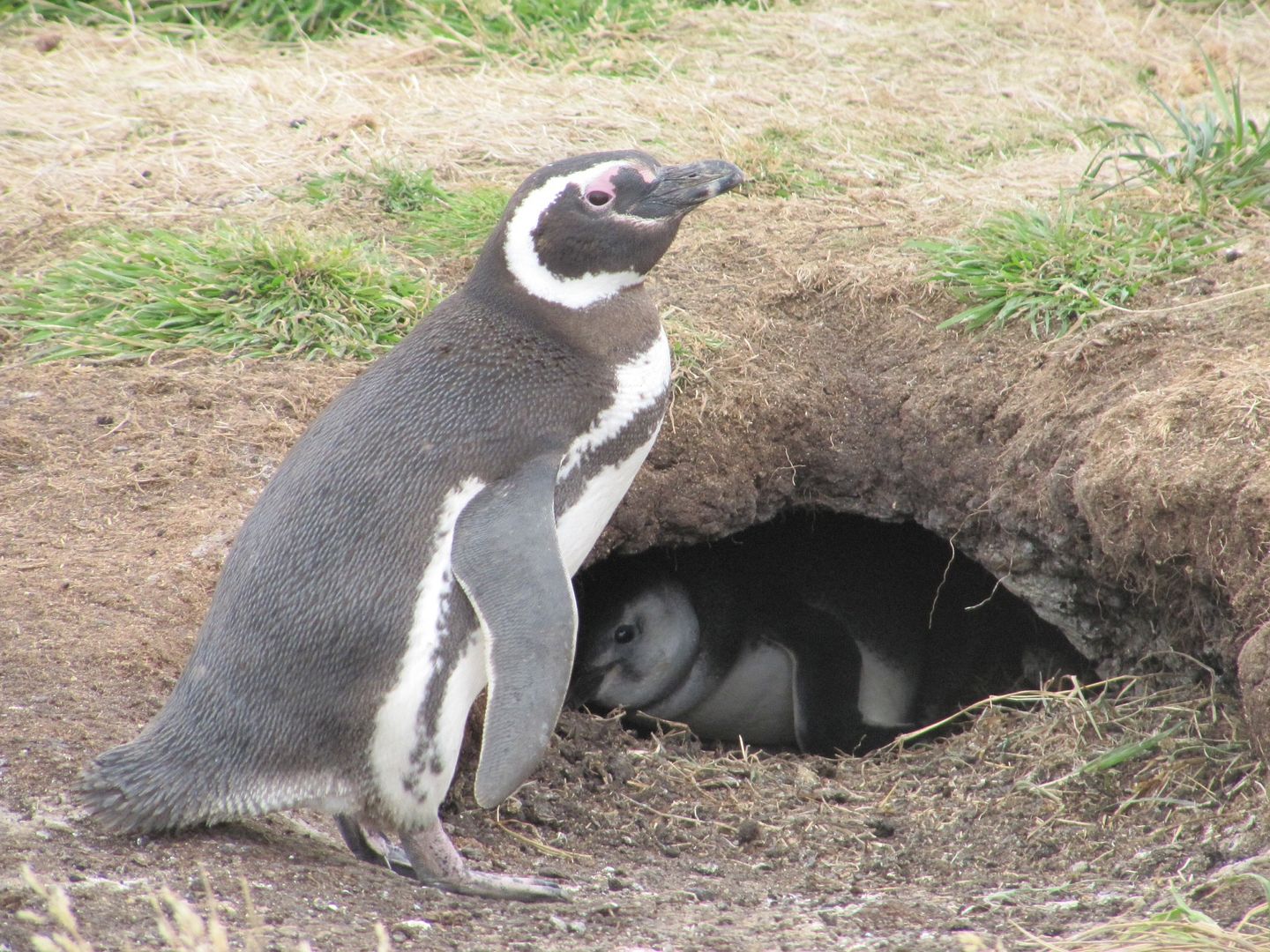 |
| Magellanic penguin and chick in burrow |
We made it through without stepping on a penguin, or getting attacked by the skuas that also had nests around and are quite vicious if you get too close to them, and got back to the lodge for tea and cake.
Flying FIGAS to Sea Lion Island
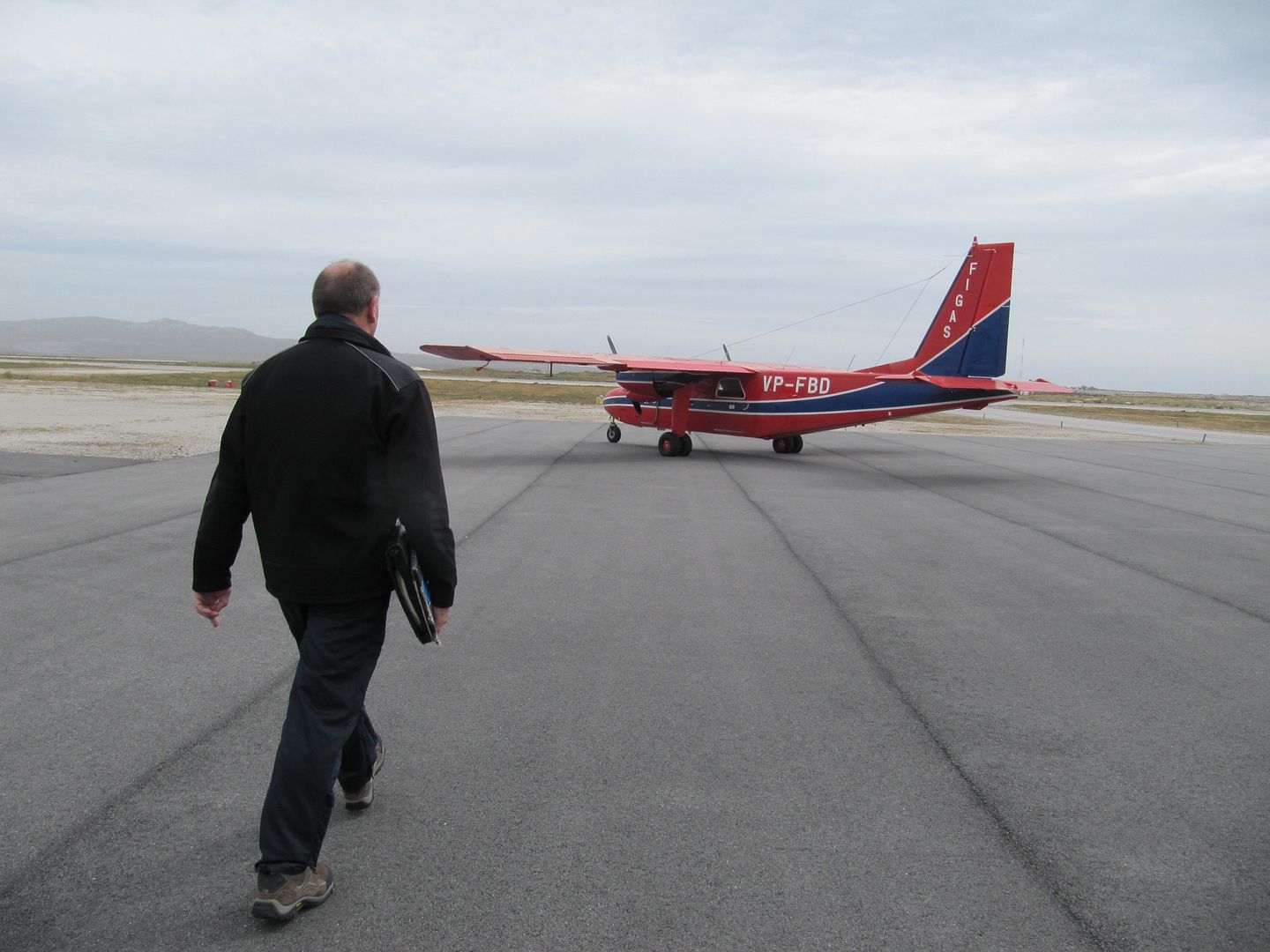 |
| Our plane and pilot for Sea Lions |
We had booked our place on a plane some months ago, but the flight itself was only confirmed the night before. We discovered which one we were on by listening to the radio at 18:15, when they announce the flights for the next day, reading out the names of who is being picked up and dropped off at each stop. We were on the second set, so had to check in at 10:30.
Although some FIGAS flights do stop at the Mount Pleasant Airport, Stanley has its own little airstrip closer to town. When we arrived a the building we were checked in, weighed, and given little luggage tags to identify that our bags were going to Sea Lion Island, all by the same woman. A couple of guys were baggage handlers, taking all the bags and any extra cargo, and driving it over to the plane once it arrived. We were met by the pilot who took us out to the plane and made sure we were all buckled in. And this was the big and busy terminal!
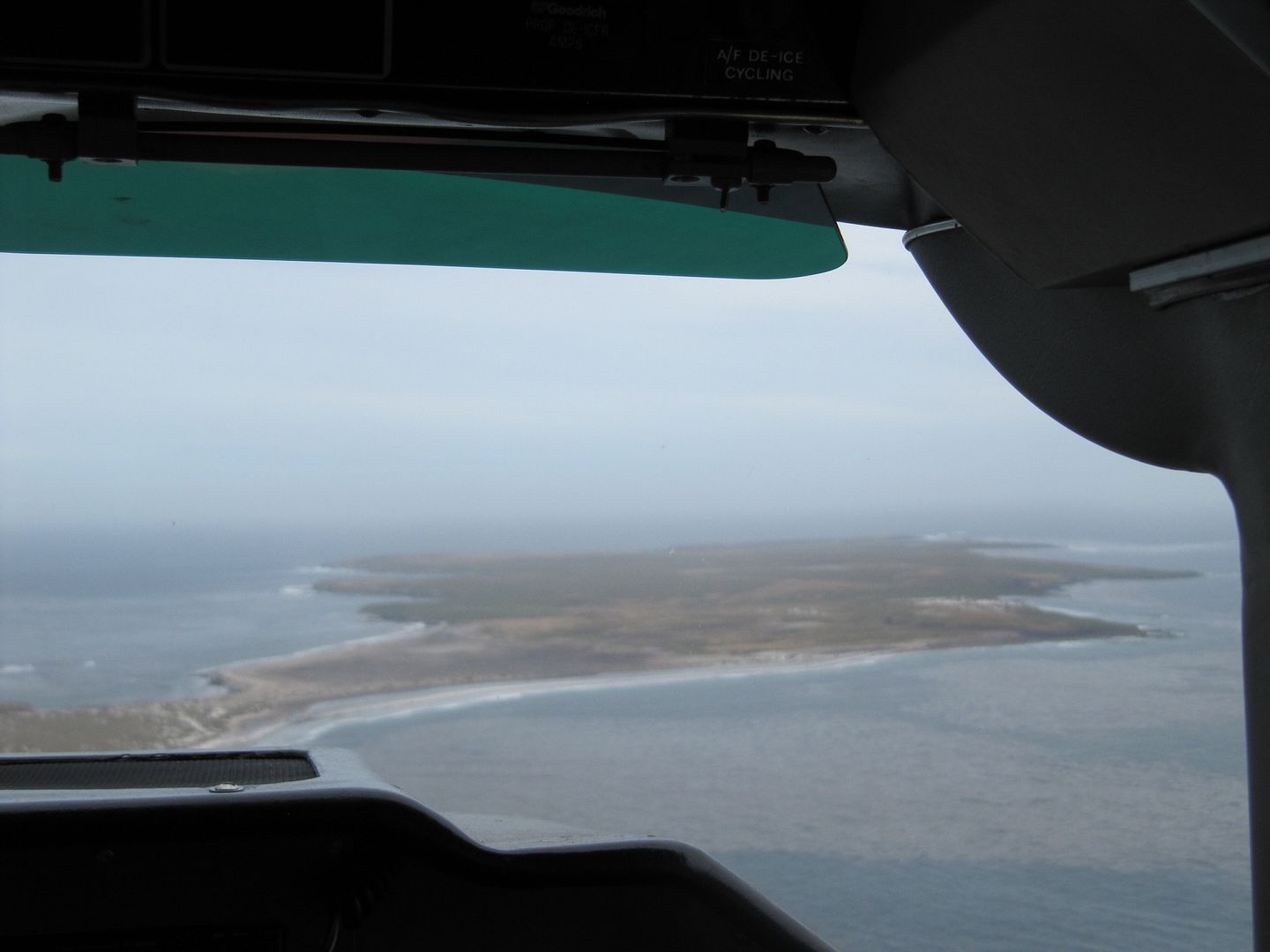 |
| Sea Lion Island from the plane |
As we approached the grassy airstrip next to the lodge, a couple of horses were ambling along the edge, but the pilot made a good landing and we were there. The lodge manager, Jenny, met us at the plane and took our bags. It was obviously rush hour here, as another plane was coming in to land from the other direction with four other new guests.
First Day on The Falkland Islands
From the amount of large camera equipment that we saw, it looks like most of the extra visitors are journalists and cameramen here to cover Prince William's tour of duty. There is certainly an air of excitement about the place even though they have said he will not be making any ceremonial visits; as we were waiting for the bus to leave the airport we heard a helicopter overhead and there was a buzz of speculation about whether it might be him flying it.
We were booked onto the bus transfer into Stanley, which took about an hour driving through mostly deserted countryside.
We did however see plenty of warning signs that indicate the minefields that were left over from the 1982 conflict.
One obvious regular was a British Blue cat which was very friendly. It sat next to us and was enjoying the attention until suddenly it got up, ran over to the bar and jumped onto an empty bar stool next to a couple of guys. We quickly realised that the reason for the sudden move was that it had heard them open a packet of crisps. It watched every crisp go from the packet to the mouth and was clearly disappointed not to get any. When we bought some crisps later it was as much as we could do to stop the cat from helping itself.
 |
| Falkland Islands minefields |
Well the Argentinean President hasn't persuaded Chile to stop any flights to the Falkland Islands yet, so we decided to go ahead with our visit as planned and hope that we can get back later.
We flew in on the one weekly flight from Punta Arenas in Chile to the Mount Pleasant airport on the military base. The flight was full and according to regular travellers, much busier than usual.
 |
| Penguin News on Prince William |
 |
| Falklands road to Stanley |
We were booked onto the bus transfer into Stanley, which took about an hour driving through mostly deserted countryside.
We did however see plenty of warning signs that indicate the minefields that were left over from the 1982 conflict.
 |
| Falkland Islands minefields |
The guide books and visitors information assure us that all of the minefields are marked, so it is safe to walk around as long as you avoid the marked areas.
We arrived in Stanley and could immediately see what a tiny place it is. Our hotel - yes we actually have a proper hotel here - is nicely in the middle of town and our room has a view across the bay. Having booked ourselves in for dinner, we set off for one of the nearby pubs to get an idea of what the place is like.
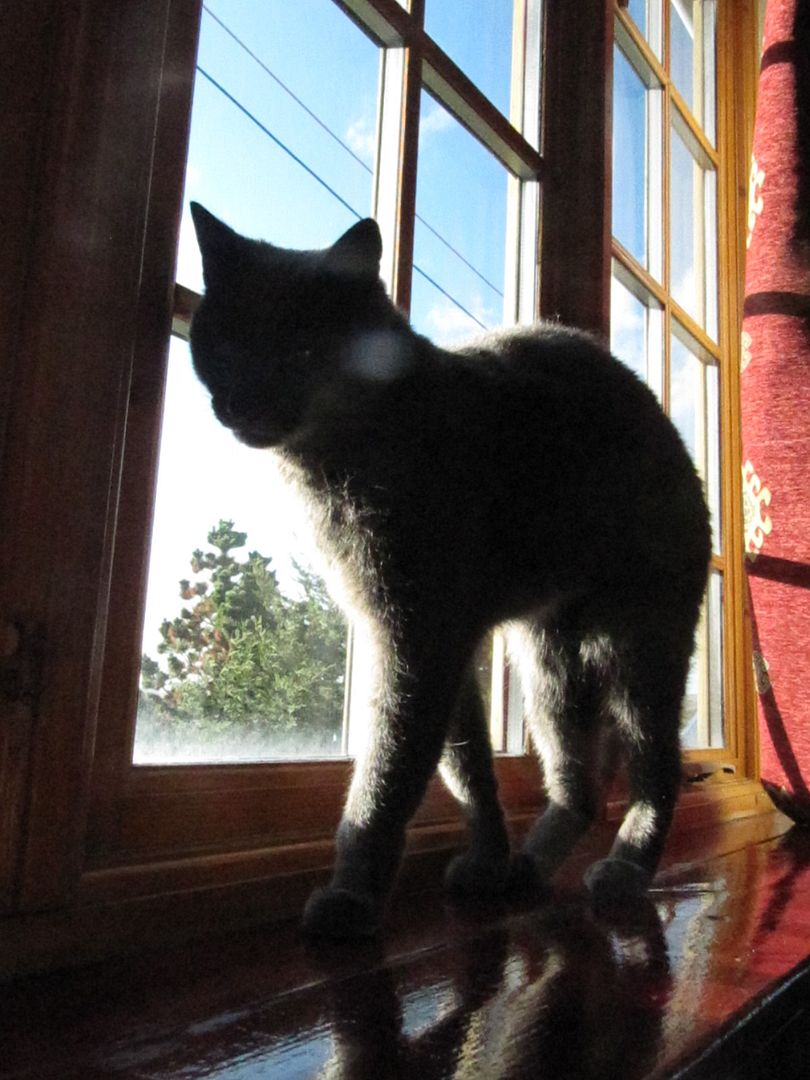 |
| Cat in the Victory Bar |
Walking into The Victory was just like walking into a traditional British pub. The room was a bit on the dark and dingy side, with four dart boards, a pool table and a few fruit machines. The bar had all the drinks and mixers that you would usually find in a British pub, with only two exceptions; they had a bottle of Chilean Pisco, and they don't have beer on draft. Presumably the breweries don't deliver quite that far! They even had walkers crisps.
One obvious regular was a British Blue cat which was very friendly. It sat next to us and was enjoying the attention until suddenly it got up, ran over to the bar and jumped onto an empty bar stool next to a couple of guys. We quickly realised that the reason for the sudden move was that it had heard them open a packet of crisps. It watched every crisp go from the packet to the mouth and was clearly disappointed not to get any. When we bought some crisps later it was as much as we could do to stop the cat from helping itself.
Tuesday, February 21, 2012
Do you know anyone who needs a house sitter?
Travelling on a budget means finding less expensive ways of sleeping, preferably ones that don't involve cardboard boxes! One option is house sitting, and we have recently signed up to a couple of house sitting sites to offer our services to the many people out there who want their houses and their pets looking after while they go on holiday. Of course Nic seems to be most interested in those that have either got labradors or something more unusual - he is already rather disappointed that we won't be around to help out the people in Hertfordshire who need someone to look after their pet racoon.
So if you know anyone who needs their home and any pets looked after while they're away, drop us a message. We'll be back in the UK from July to mid October, but could be interested in ones further afield too, while we travel.
So if you know anyone who needs their home and any pets looked after while they're away, drop us a message. We'll be back in the UK from July to mid October, but could be interested in ones further afield too, while we travel.
Photos up to date
After various problems with uploading, I have finally managed to catch up with adding photos to the older blogs that didn't have them. If you want to take a look it was the Salta to Lima section from September and October that was missing - and yes, Katie and Amy, that does include the guinea pig dinner in Ariquipa.
Sadly, am still struggling to find a way to get these older photos onto the slideshow though, so you won't find them there, only on the blogs themselves.
Sadly, am still struggling to find a way to get these older photos onto the slideshow though, so you won't find them there, only on the blogs themselves.
Sunday, February 19, 2012
Viewpoints, wildlife and the Grey Glacier
 |
| Torres del Paine national park |
On the last full day, the easy option was so easy that even I decided to get off my butt and go with them. And as Nic had already done a similar walk to the challenging option, and was still coping with his blisters, he stuck to this one too.
 |
| Guanaco |
 |
| Rhea |
We left at a civilised 10:30am and drove around the park, stopping at various different viewpoints along the way. Obviously the views weren't as good as those that you got if you walked closer to the peaks, but they were still impressive and much less effort.
As we walked up to one of the lookouts, we passed by a set of Guanaco bones, which had presumably been a puma kill and then picked clean by the various smaller animals and scavengers in the park. Once at the viewpoint we got some good condor sightings as well as the views of the mountains.
 |
| Patagonian fox eating another fox |
We also saw rhea, live guanacos and a Patagonian fox. The fox had found the remnants of a puma kill, which looked like another fox, and was happily if slightly warily, eating while we watched.
 |
| Salto Grande waterfall |
We stopped off at the Salto Grande Waterfall. The walk up to this was incredibly windy, and it was actually quite an effort to stay on your feet at times. You could quite see how it was that the wind carried the fire so effectively. And we saw plenty of evidence of the fire during our drive, but I am posting on that separately.
 |
| Torres del Paine national park |
After stopping off to eat our lunch we headed for the Grey Lake. Here we took a short walk down to the beach and got into a zodiac to reach the ferry that was going to take us around the lake and to the edge of the Grey Glacier.
 |
| Torres del Paine national park |
The ferry was back on its normal duties now after having been pressed into action rescuing people who had been stranded by the fire. The captain had only had about three sleep a night for three days as he made multiple journeys carrying firefighters out to try to control the fire and collecting walkers and staff whose route back was cut off.
 |
| Grey Glacier |
And all this trying to land the boat on a rocky shoreline, with no piers, in very high winds creating huge waves on the lake. Thankfully by this time he had caught up on his sleep and wasn't having to cope with such difficult conditions.
 |
| Grey Glacier |
The trip across the lake was best done from inside the boat. The waves were fairly strong, and even going slowly, the icy cold water splashed up over the front of the boat. When we got to the glacier itself, the water was calmer, so we ventured out into the cold to look at the glacier and take our photos.
There was a free drink included in the trip, I think solely for the novelty of serving the drink with ice from the glacier. Not that we needed any extra ice by this time.
The glacier was nice enough, but having recently seen the Perito Moreno, we decided to head back into the comparative warmth of the cabin after a while, and look at the rest through the window.
| Grey Glacier |
We were nearly driven back out again by a rather noisy, grizzly and irritating child, and a number of us agreed that we were sorely tempted to throw him overboard. We just about resisted, but I think we all had our fingers crossed that he would fall in when he started moving around early on the zodiac on the way back!

And the moral of the story is .....
..... don't light fires.
The fire in Torres del Paine started on 27 December 2011 and burned for nearly two weeks. Even when we visited from 25 January some parts were still smouldering.
There were some areas where the forests had been completely cleared of trees and bushes, leaving only charred earth and the burned stubs of the trunks.
The burned areas looked especially stark at the areas where they met with a lake or pond, and the reeds at the side were still green and bright having been protected in the water. These devastated areas were sad to see and you can quite understand why the people who work here, and in some cases grew up close by, are so upset at the loss.
But whilst clearly you would never wish this to have happened, there were some areas that we passed where the fire had left something that in my view was absolutely beautiful in its wake. There were some sections where the trees had not been razed but instead had been left whole and completely blackened.
 Because these trees have such wonderful shapes of their branches, the simple effect of being bare and totally black does itself look amazing. They were particularly effective where the blackened trees were set against the backdrop of the azure blue of the lakes. I would have loved to have been able to spend time photographing this, but figured that it would be unreasonable to ask the driver and guides to stop to let me do so when they clearly are upset at the sight of the damage.
Because these trees have such wonderful shapes of their branches, the simple effect of being bare and totally black does itself look amazing. They were particularly effective where the blackened trees were set against the backdrop of the azure blue of the lakes. I would have loved to have been able to spend time photographing this, but figured that it would be unreasonable to ask the driver and guides to stop to let me do so when they clearly are upset at the sight of the damage.I spoke to two of our guides about this afterwards. One is an artist, and said she agreed that the trees have a beauty of their own, and has herself been out photographing them. The other could see what I meant, but could not herself see beyond the destruction to find any beauty in it. I can understand that when you are so close to something it is hard to see anything positive in it, perhaps especially because her partner has lived here all his life and is devastated by the fire.
But even if some of the trees do look beautiful now, the lasting effects of the fire are terrible. We passed by areas where the fires had been in 2005 and in 1980. Even thirty years later, the areas of forest that burned have only got grasses and low shrubs. The forests haven't returned and won't for many years yet. Seeing the huge amount of lasting damage that the fire causes really brings it home why they ask you to be so careful with even the smallest bit of fire or cigarettes in a place like this.
 No one (except for some very sick people) would ever intentionally cause a fire like this, but some people ignore the rules because they think the rules are excessive or just reckon that the rules are meant for others. Many people think they can get away with breaking a rule because they are sensible and will be more careful. But they are wrong. It takes only the tiniest thing to go wrong, which may be completely out of the person's control, and a fire like this breaks out. I for one will make absolutely sure that I follow national park rules in future.
No one (except for some very sick people) would ever intentionally cause a fire like this, but some people ignore the rules because they think the rules are excessive or just reckon that the rules are meant for others. Many people think they can get away with breaking a rule because they are sensible and will be more careful. But they are wrong. It takes only the tiniest thing to go wrong, which may be completely out of the person's control, and a fire like this breaks out. I for one will make absolutely sure that I follow national park rules in future.One small point that did amuse us though was the supposedly divine intervention when the little roadside shrine that was in the fire area managed to stay undamaged. Personally I think that may have had more to do with the little stream of water flowing behind it that probably kept the vegetation around it damp and protected. Of course if it was divine intervention then it was a little selfish that it allowed all of the area around it to burn so badly while keeping itself safe!

Subscribe to:
Posts (Atom)








